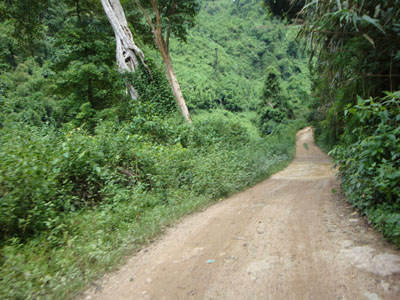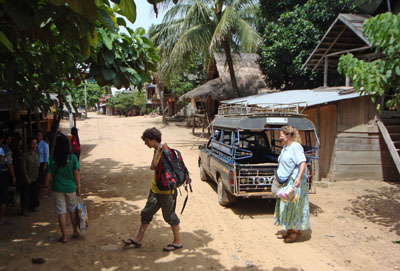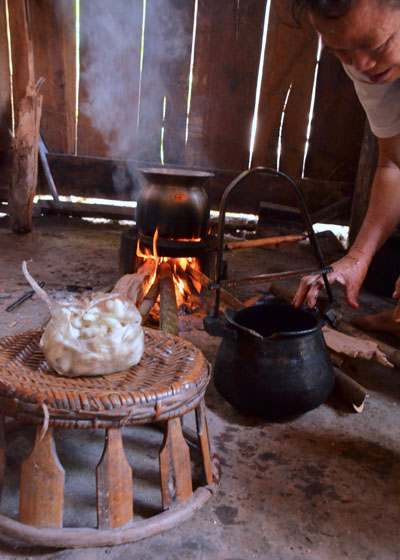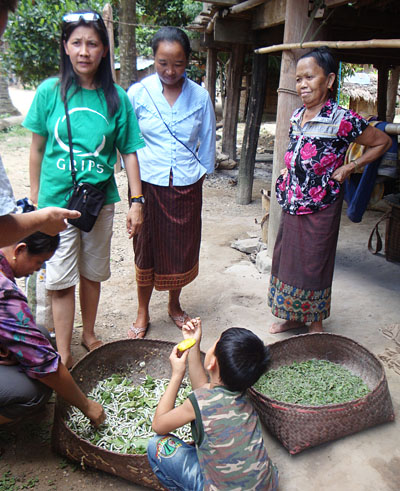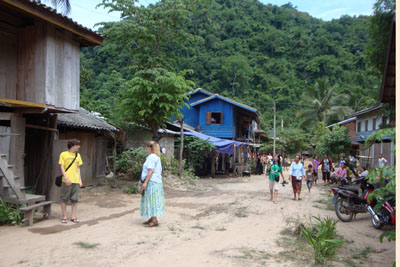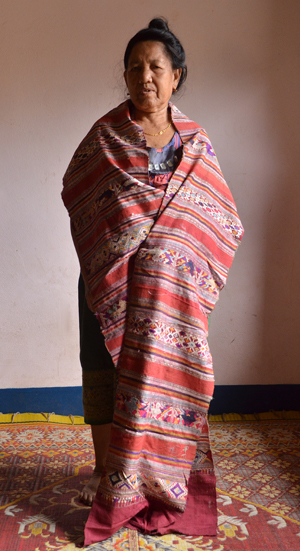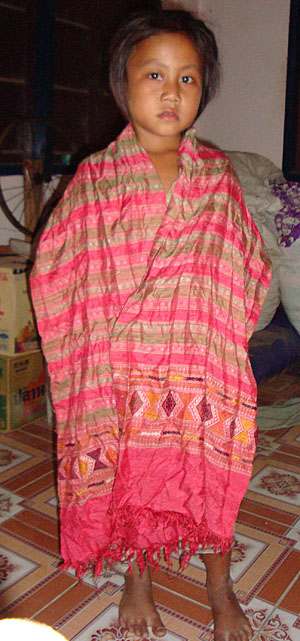Raising Silk for the World’s Finest Weavers: Adventuring to Ban Tao, Houaphon Province, Laos
Our saungtheaw, a pick-up style public “bus” with two hard benches in the bed, finally emerges from the narrow rutted jungle track that had followed the tumbling Xam River for an hour, and we lurch to a stop in front of Ban Tao’s sole store. Our family and Mai, our translator and good friend, and several others along for the ride, stretch the kinks from our jarred bones and, seeking shade from the close and humid sun, huddle in the shade of a scraggly papaya tree. A half dozen locals adults, and perhaps 15 kids, all crowd close. It had been a couple years, we are told, since anyone remembers white people visiting their town.
The store sells canned and dried goods as well as Chinese-made tools and plastics. Several varieties of potato-chip-like snacks in bright foil packets wait for attention. A fridge – and electricity, although sporadic, has only recently reached Ban Tao – proudly displays cold cans of Coca-Cola and bottles of Beer Lao and water. A few baskets of fresh vegetables and jungle fruits sit in front, seeking customers. A 10-pound iguana, with a trickle of blood on it’s alert face, is leashed with a rope to a wooden post – no, one won’t find fresher meat in the area. (And guess what Mai’s family had for dinner that night!).
We had traveled to Ban Tao because it is renown for its sericulture. For generations, this small village of perhaps a couple hundred people has been central to raising the highest quality silk required by the incredible weavers of Houaphon Province.
The elected head of the village appears, and Mai introduces herself and us. He nods and says he is honored that we would come to their village, but he is sad that we have come during the monsoon season as this was not a time for harvesting the silk – they just keep enough silk worms going to maintain their “crop” for the best growing season. He leads us, and the growing contingent of curious kids, to a small thatched roof house and immediately directs a group of young people to start a fire. He was determined to show his special guests the full sericulture process. Smoke filled the now-crowded room – ten, fifteen, twenty people crowd in. Zall, eager to escape both the crowd and billowing smoke, pulls out a frisbee and a gaggle of boys rush out to play in the dirt-track street. The village head excuses himself – he has to attend an important function in recognition of a local policeman’s promotion.
Some silk cocoons appear, presumably a few months old, and an elder woman, who was obviously now in charge of the production, quickly sets up pots of water to boil and pulls out a set of long sticks that helps her handle the cocoons. Maren wears a full smile, a bead of sweat hanging on her nose; Mai is trying to translate for three simultaneous talkers; a baby starts to cry. The grandmother sits down at the fire and the crowd pulls back a bit. Yielding the two long sticks as if they were batons, she demonstrates how one takes a worm’s now-boiled cocoon and delicately pulls from the tiny, papoose-like bundle strands of exquisite thread that has been the treasure of royalty for millennia. We have seen the procedure before, but it seems important for our relationship with these kind people that they demonstrate their full expertise. Who are we to dictate the pace of a visit or the content of the exchange?
An hour later we are led to another home. In the shade under the elevated floor, behind the fencing that keeps the roving chickens and ducks out, are trays of silkworms devouring fresh mulberry leaves. The continuing “crop” of silk is being carefully nurtured. Demand for silk is high (thanks especially to the growing wealth of neighboring China and Vietnam), and for Ban Tao, this is the essential source of business that has supported the village for generations.
Mai excuses herself to spend some personal time with an aunt and uncle who live in town (what town doesn’t she have relatives in?!). It must be exhausting to have Lao and English grammar jabbering simultaneously in one’s head, and we’ve always greatly appreciated the fact that Mai has never hesitated to set aside some personal time to “clear the noise.” It also forces us to practice our Lao language skills and hone our skills for developing connections without the benefit of a spoken vocabulary. Luckily, smiles and laughs, hand and body signals, and the willingness to be a bit of a ham has taught us that clarity can be sacrificed without a loss of personal connectivity and deeper, shared human understandings.
The sun’s bake drives us into the cool comfort of the village head’s home, a cement-brick structure with wooden shutters on the windows and a corrugated metal roof. The chief is still at the promotion party, but his wife treats us to glasses of cool water (from a bottle, thank you!), and then she pulls out some older silks made in previous generations. Mai returns just in time and Maren and the chief’s wife engage in a deep discussion about the difference between older and newer textiles, local dyes, and the village’s sericulture tradition. I watch Maren secretly drool when a 50-year-old handwoven silk mosquito-net border appears.
Zall stretches out in front of a slowly-turning fan and seems to melt into the ever-so-slightly-cooler vinyl floor. It is hot.
Escaping into the bright heat, I hear pop music up the hill and turn my head. Some man – the village head it turns out – is waving for me to join. Then another dozen faces peer over a bamboo balcony, and a young man and woman, with big smiles, rush down to my side and insist, with a flurry of words, that I join the party. I’m handed a short glass of Beer Lao, and, following local tradition, I offer a nod of thanks and slork it down in one gulp (ah – a cold one on a hot day can be a good thing!). I hand back the glass only to be handed another a moment later, and then a tray of unidentifiable fried meat chunks (dog?) is offered, and a plate of bananas and some other plum-like fruit and then another glass of beer. The Lao pop music – what I believe to be the same couple songs playing over and over – is turned up. The gentleman getting the promotion, who to me looks no older than 16, throws his arm around me and says something in a loud, slightly-slurred voice and everyone, including me, laughs. More toasts, more beers and then a giant jackfruit is cut open and shared. The village head comes to my side and over the din of a sappy pop song and the laughter offers what seems to be a more serious-minded toast. He looks me straight in the eye, and drinks the short glass himself. Immediately he refills the glass and hands it to me. I offer, in English, what I hope sounds like a humble thank you and then lift a toast to our shared moment of friendship and joy and indulgence. Everyone cheers – common language is so overrated sometimes.
An hour later, just as the promotion party was dispersing, Maren and Zall, each with an armload of new treasure, track me down. “It’s alright” I stammer. “I’ll just take a catnap on the ride back…”
The next day, back at our accommodations in the more central town of Xam Tai, the head of Ban Tao suddenly appears. He has a friendly business relationship with our dear friend Souk, a master dyer and weaver, at who’s home we are staying. We share some food and drink (again the traditional exchange of beer – at 10 AM – although not enough to alter the day’s trajectory of tasks). Mai translates that the most important reason he visits today is to play a game of petanque (bocce ball) with me, one-on-one, on the small court set up in Souk’s front area. Mai’s eyes tell me that his invitation is formal and important – we had not yet had our full time together.
I can’t remember who won. But that shared half hour of petanque has really stuck with me. You don’t need shared language to share time and purpose and affection. We smiled and chatted in our respective languages, the content of the words secondary to the meaning of the communication. We laughed at our errors, cheered at our luck. Fate and opportunity – the ties that create friendships and business and purpose on all human levels – had created a bond that needed only be acknowledged to be empowered. Our roles were assured; our relationship formalized. And perhaps, in a small but important way, our larger purpose validated.

